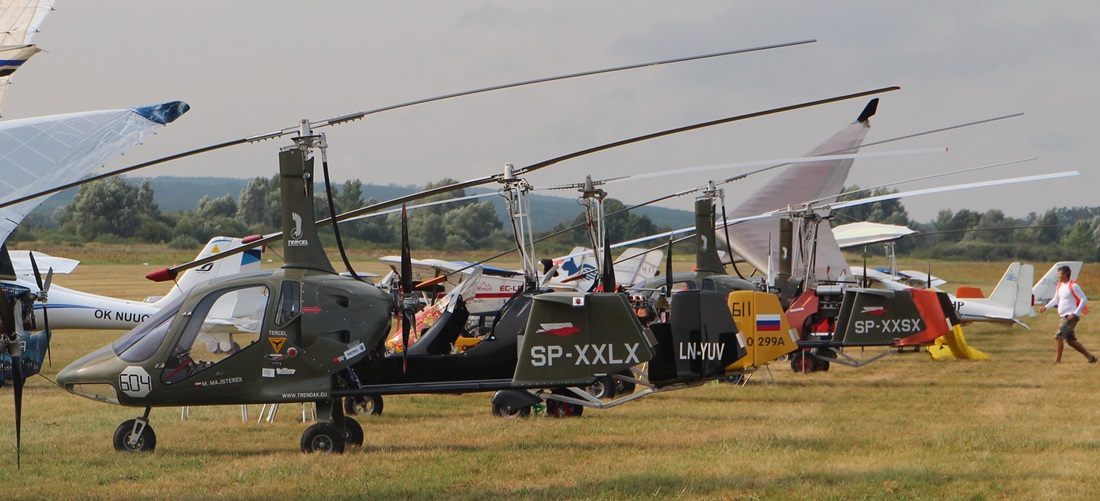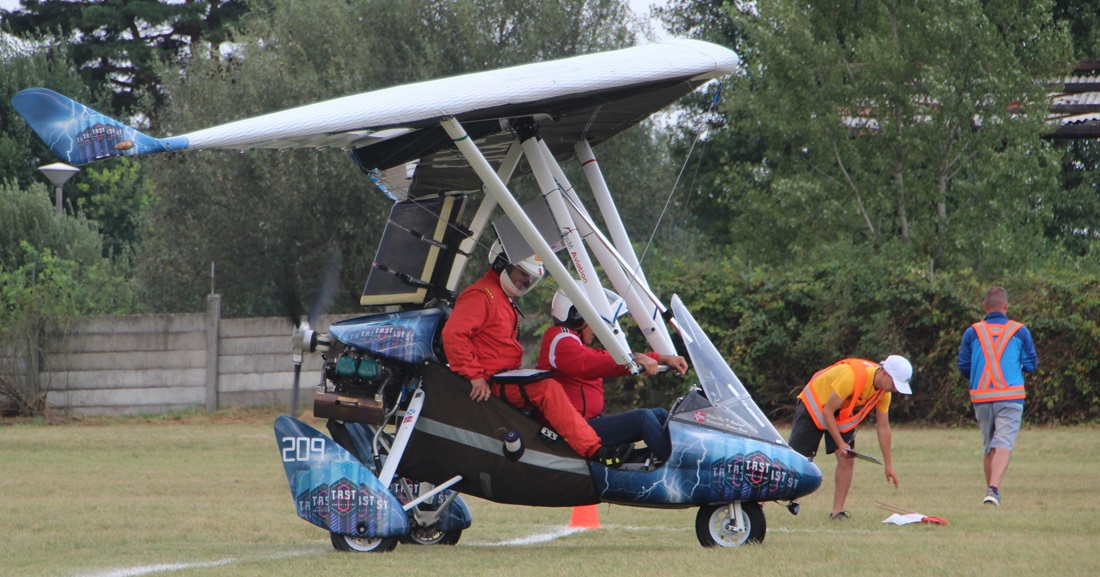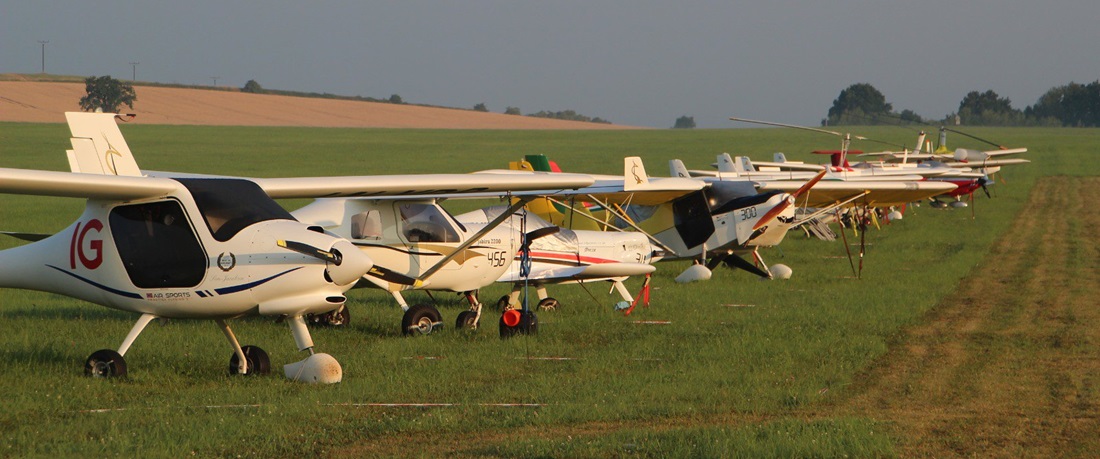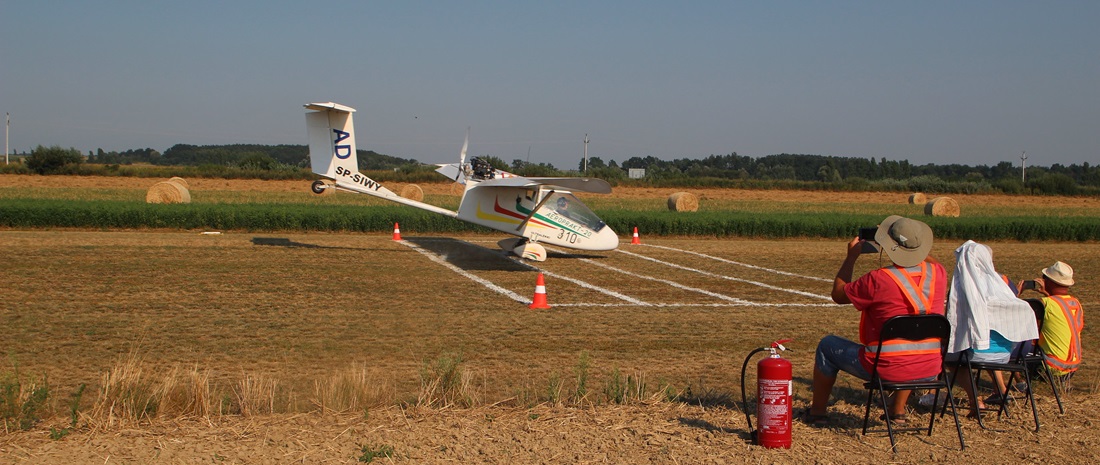FAI Microlight and Paramotor Commission (CIMA)
Microlights
What is a Microlight?
A Microlight (or ‘Ultralight’) is a lightweight, powered aircraft with one or two seats.
Three types of microlight exist:
- Fixed wing: resembles a small plane, nowadays usually featuring a closed cockpit, and manoeuvred via aerodynamic control.
- Flex wing: the flexible, hang glider style wing is manoeuvred as the pilot shifts their weight from side to side. These are launched using a wheeled ‘trike’.
- Autogyro: spinning blades provide the lift (similar to a helicopter), but powered by a propellor engine at the back.
For a microlight/ultralight aircraft, the minimum speed at maximum take-off weight (MTOW) is less than 83km/h. The MTOW depends on whether there are one or two people in the aircraft, and on the aircraft’s type, eg. landplane, seaplane/amphibian.

Autogyro lined up on the airfield at the 16th FAI World Microlight Championships 2018. Image: Wolfgang Lintl
A brief introduction to microlights
Microlights developed from the concept of a powered hang glider.
In the 1960s and ‘70s, hang gliding and paragliding enthusiasts not located near a high-altitude take off spot were forced to travel to find suitable launch sites, and were seeking a solution for powered take off. During this period, the oil crisis obliged some conventional aeroplane pilots to look towards a more “minimalist” aircraft, economical in terms of both construction and use.
This era therefore saw the first trials of motorised hang gliders, powered by modified two-stroke engines of about 10 hp, most of them originally from chainsaws. The first such aircraft were marketed in the early 1970s, with France paving the way in development.
Although these first motorised microlights did not fly very fast (50 km/h at most), they did have the advantage of being real aircraft that could be purchased at relatively affordable prices, and easily stored.

A two-seater trike at the 16th FAI World Microlight Championships 2018. Image: Wolfgang Lintl
The first microlights were of the flex wing, weight-shift type (equipped with trikes comprising the seat and the engine) and were intended for pilots with hang gliding experience, as the piloting techniques were similar. Flex wing microlights have an open cockpit and are steered using the wing’s base bar. The flexible wings can be folded and taken to the pilot’s home in a trailer, although some pilots prefer to store their microlight at an airfield.
A few years later, the first so-called three-axis microlights were developed in North America, resembling aeroplanes in their shape and in the piloting methods required. Initially featuring a semi-open cockpit, more modern fixed wing microlights feature a closed cockpit, often with heating. Generally, pilots of fixed wing microlights keep their aircraft in a hangar at their local airfield.

Fixed wing microlights at the 17th FAI World Microlight Championships, Czech Republic 2022. Image: Wolfgang Lintl
About Microlight competitions
The first FAI World Microlight Championships was held in Millau, France, in 1985.
An FAI World Microlight Championships usually takes place every two years and features solo and two-person tasks in each of the three categories of microlight, meaning six classes in total are contested:
- Classic classes - RAL 1 T (Movable Aerodynamic Control / Landplane / Flown solo)
- Classic classes - RAL 2 T (Movable Aerodynamic Control / Landplane / Flown with two persons)
- Classic classes - RWL 1 T (Weight-shift Control / Landplane / Flown solo)
- Classic classes - RWL 2 T (Weight-shift Control / Landplane / Flown with two persons)
- Autogyro - RGL 1 T (Autogyro / Landplane / Flown solo)
- Autogyro - RGL 2 T (Autogyro / Landplane / Flown with two persons)

Filming a landing at the 16th FAI World Microlight Championships 2018. Image: Wolfgang Lintl
How do tasks and scoring work?
Tasks are set from the CIMA Task Catalogue:
Navigation: Tasks for flight planning, navigation, etc with no fuel limit. This counts for 65% of the total value of the tasks flown.
Economy: Tasks for fuel economy, speed, duration, etc with limited fuel. Carries 20% of the total value of the tasks flown.
Precision: A precision landing marks the first touchdown with no damage to aircraft or pilot. Tasks count for 15% of the total value of the tasks flown.
During a competition, the director will give specific information during the briefings, such as take off and landing times, the course, fuelling arrangements. These will all be defined in accordance with local regulations.
What does the FAI Microlight and Paramotor Commission do?
The FAI Microlight and Paramotor Commission (CIMA) – whose acronym is from the French name, Comité International de Micro Aviation – was established in 1981.
The commission supports and develops the sport, and provides administration for rules changes, sporting events, awards and records.
The CIMA bureau meets annually and welcomes delegates from FAI member countries.
Microlight Awards
FAI Colibri Badges recognise standards of achievements in microlight (and paramotor) piloting at four levels: Bronze, Silver, Gold and Diamond, to recognise for example, competition performance or distance flights.
At the annual FAI Awards, CIMA can recognise a pilot or crew’s FAI world record flight with the Ann Welch diploma, or an outstanding contribution to the development of microlight air sport with a Colibri Diploma. Learn more about CIMA Awards.
Microlight rECORDS
The FAI Microlight and Paramotor Commission supports record attempts and ratifies record claims. The first microlight record - for distance in a straight line without landing - was set by British pilot Peter Jonathan Davies in 1984 for flying 545.52 km in a Shadow CFM microlight. The R-Absolute speed record stands at 323,82 km/h, set on 16 Dec 2015 by Alberto Rodolfo Porto from Italy, in an SEA Risen.
Header image: Aircraft at the 15th FAI European Microlight Championship, Lithuania 2019. Image: Wolfgang Lintl

